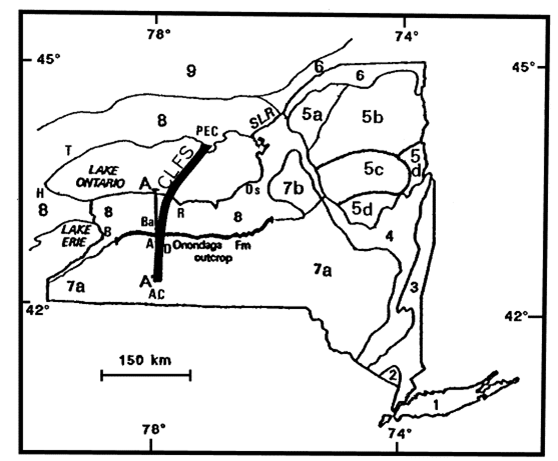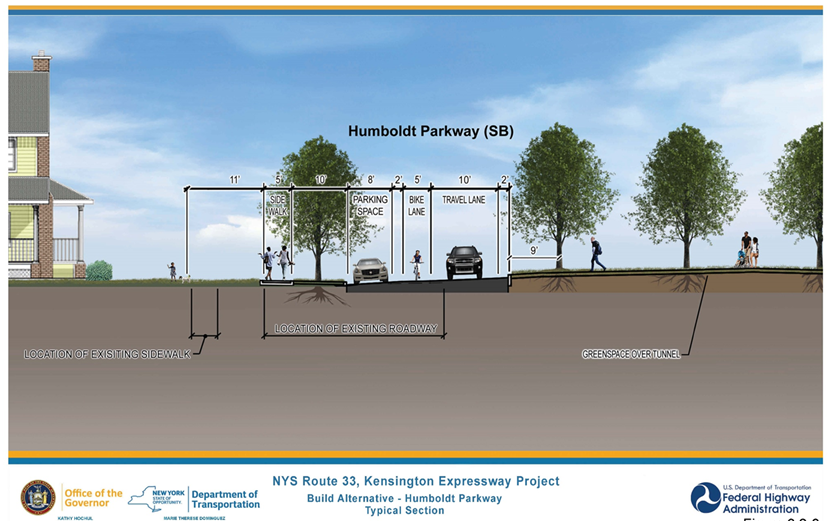I. Environmental Review Process
The FHWA and NYSDOT determined that the preparation of an EA was appropriate for the Kensington Expressway Project based on the above definition. However, this EA determination did not dictate the level of analyses or public engagement that have been conducted for the Project. The traffic, social, economic, and environmental analyses that have been conducted for the Project would not differ if an EIS were prepared. For example, the air quality analysis that has been conducted for the Project would not be any different if an EIS were prepared. This level of analyses was needed in order to determine the effects of the Project, mitigation measures, and whether any adverse effects would be significant. The agency, public, and stakeholder engagement has been tailored to the Project and was not based on what level of environmental documentation was being prepared.
II. Project Scope, Limits and Alternatives
For the Kensington Expressway Project, the project limits are Best Street and Sidney Street. The northern limit was extended 600 feet during the project scoping process in response to public input. These limits were selected to include the areas where NYS Route 33 is already depressed (reducing the cost and complexity of building a tunnel), provide connectivity with existing parkland and community resources, and factor in engineering and environmental constraints, such as the location of Scajaquada Creek and the NYS Route 33/NYS Route 198 interchange.
The Project has been and will continue to be designed to not preclude a future extension of the tunnel as part of a separate, independent project. However, an extension of the tunnel beyond the project limits is not part of the scope of this Project.
- Safety (diverting traffic onto radial streets would result in higher crash rates on local streets with intersections compared to retaining the expressway);
- Increased crash rates with pedestrians and bicyclists due to their exposure to increased traffic on local streets;
- Conflict with potential Complete Streets/road diet improvements to radial streets undertaken by the City of Buffalo to increase nonmotorized accessibility and safety;
- Increased emergency vehicle response times and decreased access to hospitals;
- Increased emissions of air pollutants near homes and community facilities, because “stop and go” traffic on local streets produces more pollutants than continuously moving traffic;
- Travel time reliability for those commuting through the area; and
- Exceeding the capacity of key roadways, such as I-190, I-90, and City of Buffalo arterial streets, resulting in traffic congestion and safety issues in other parts of the city or requiring widening/expansion that could have social/environmental effects.
III. Schedule, Cost, Funding and Maintenance
IV. Construction Effects and Mitigation
- Implement an outdoor air quality monitoring program during construction.
- Real-time particulate monitoring at numerous locations, including:
- Publicly accessible results;
- Required operational changes if levels approach what is allowable within 24 hours;
- If levels exceed the allowable standard, suspension of applicable construction activities until issues are identified and corrected.
- Require the construction contractor for the Project to use lower emission equipment.
- Require the construction contractor for the Project to prepare and implement a Dust Control Plan.
- Limit idling time for diesel-powered equipment to three consecutive minutes to limit air pollution.
Pre- and post-construction surveys of building conditions would be conducted within a survey area of up to approximately 300 feet from the Project site. This estimated distance for the surveys would be refined during final design, as appropriate.
In addition, a Construction Vibration Mitigation Plan would be developed during final design that would include:
- A communication and public outreach plan throughout the construction period;
- Blasting program designed to avoid the potential for damage to structures;
- Require test blasts, prior to construction blasting;
- Require vibration and noise monitoring per the blasting program.
- If at any time it is determined that vibration and/or noise levels are unacceptable, the problematic construction operations would be suspended until a plan to mitigate the vibration issues has been approved by NYSDOT.
There would be temporary closures of Dodge Street and East Utica Street. Temporary bridges would be used to maintain east-west connections at Northampton Street and East Ferry Street throughout construction. Additional temporary pedestrian/bicycle only bridges would be constructed to ensure that crossings are no more than 1,300 feet apart.
The construction contractor would be required to prepare detailed work zone traffic control plans consistent with the construction traffic commitments made in the Environmental Assessment.
- Shallow rock removal of less than five feet would be required between 400 feet south of Best Street to Dodge Street;
- Rock removal would not be required for the approximately 1,600 foot length between Dodge Street and just south of Landon Street;
- Shallow rock removal of less than five feet would be required between approximately Landon Street and East Utica Street;
- Rock removal of greater than five feet would be required from East Utica Street to 50 feet north of Brunswick Boulevard. The average depth of rock removal in this area would be approximately 9 to 10 feet. The deepest rock removal would be approximately 17 feet near the Sidney Street tunnel portal;
- Shallow rock removal of less than five feet would be required from north of Brunswick Boulevard to just past Hamlin Road.
V. Air Quality
Under normal operations, the use of jet fans would not be needed, meaning that they would only be turned on in rare occasions. Air quality sensors within the tunnel would be installed to identify such an occasion (such as a breakdown in traffic flow). In cases like this, the sensors would automatically turn on the jet fans to increase air flow through the tunnel, which would draw in fresh air from the entrance portal, dilute the concentration of exhaust fumes, and carry the diluted exhaust fumes to the exit portals where they could disperse into the atmosphere. When normal operating conditions resume, the jet fans would automatically be turned off.
Minimization/mitigation commitments near the tunnel portals include interior tunnel washing to control dust; planting trees and vegetative buffers; use of the longitudinal ventilation system to dilute and disperse pollutants; air diversion slots in tunnel ceiling near portals; and wall treatments to remove air pollutants.
The need for air treatment was evaluated during the preparation of the Environmental Assessment. Based on the air quality analysis results and the project design, air treatment is not necessary or warranted. Pollutant concentrations under the Build Alternative in the areas near the tunnel portals would remain well below the health-based federal standards.
Air quality concentrations would further decline over time as older vehicles, which produce greater emissions, are removed from the overall fleet of vehicles traveling on NYS Route 33 every year.
VI. Greenspace on the Tunnel Cap
VII. Right-of-Way Acquisition
Small areas of land (in most cases, land already adjacent to the existing roadway) would need to be acquired for construction of roadway features such as the roundabout, tunnel walls, roadway widening, sidewalks, curb ramps, water services, and traffic signal infrastructure. The majority of the areas to be acquired range from 0.0004 to 0.0157 acres in size (17 sq. ft. to 683 sq. ft.). Several temporary easements (short term leases) for water line replacements would also be needed. These acquisitions and temporary easements would be conducted in accordance with State procedures.
VIII. Workforce Development/Local Hire
- In coordination with FHWA, NYSDOT will include a local hiring preference in the contract documents for the Kensington Expressway Project to encourage local hires for the contracts.
- NYSDOT will advertise training programs and construction employment opportunities at public meetings and the Project outreach center.
- NYSDOT will monitor the local hiring metrics throughout the Project and conduct regular meetings with partnering agencies to discuss progress and any steps to modify the initiatives.
IX. Environmental Justice
The public engagement plan for this Project was developed and is being implemented to provide opportunities for meaningful engagement and participation by environmental justice populations in the transportation decision-making process for the Project. Ongoing engagement activities conducted by NYSDOT for this Project have included establishing a staffed project outreach office in the project area, holding regular monthly stakeholder meetings to receive input from community groups and organizations, attending community events, and holding formal public meetings.
X. Indirect Effects
Ultimately, the administration of property assessment and taxation is under the authority of the City of Buffalo. Furthermore, potential increases in property values could be offset by Project benefits, such as an increased tax base and local spending.


